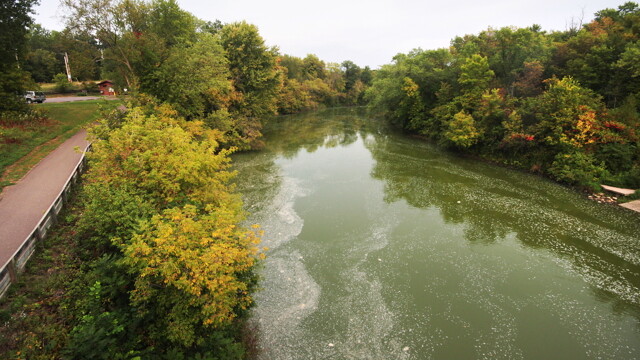Troubled Water
change needed to improve the Red Cedar Watershed
Emily Kuhn, photos by Andrea Paulseth

In the Netherlands, watersheds are considered such a vital part of life that local governments are organized around them, rather than by cities and counties. Watersheds are just as important to life here in the Valley, yet many of us aren’t conditioned to consider how our actions impact water quality. But they do – and the algae blooms that cover Tainter Lake and Lake Menomin each year are a prime example of how agricultural and urban land use practices affect the water that our industries (agriculture, tourism, and recreation) depend on.
“When we’re fertilizing our lawn, we use a combination of nitrogen, potassium, and phosphorus. Plants really like phosphorus and, with it, will turn green and grow. Well, algae is a plant ...” – Dan Zerr, UW-Extension Natural Resource EducationBoth lakes are part of the Red Cedar Watershed, where water quality problems like the growth of blue-green algae have been documented for decades, and today are a hot-button issue in Menomonie’s mayoral race. The problems are caused by high levels of phosphorus, which runs off urban and agricultural land. Although solutions to the problem have been slow to develop, there are actions residents can take to help local bodies of water, and a March 22 conference at UW-Stout has been organized to educate the public about this issue. The first annual conference is titled “The Red Cedar: Land, Water, and People Coming Together,” and will discuss solutions to phosphorus-related problems and, hopefully, make people aware of the situation so that water quality in the basin can begin to improve.
“All of the watershed impairments are a shared problem, and responsibility for cleaning them up is also a shared problem,” stated Dan Zerr, UW-Extension Natural Resource Educator and planning committee member for the conference. “We want people to know what the Red Cedar Watershed is, and how important it is. We want to raise awaReness.”
That awareness begins with an understanding of the Red Cedar River Basin. The basin drains an almost 1,900-square mile area of West Central Wisconsin. Tainter and Menomin lakes are located at the base of the watershed, and since the river system isn’t natural (both lakes were created by damming rivers) they’re the perfect place for sediment to settle after its journey through the watershed. Although the northern parts of the basin are largely forested, agriculture is the primary land use in the rest of the basin (and the runoff from phosphorus-rich farms is part of the problem). Since phosphorus is essentially plant food, an influx of the nutrient in water that isn’t moving creates an environment in which algae will thrive. In fact, one pound of phosphorus has the potential to produce 500 pounds of algae!
 “When we’re fertilizing our lawn, we use a combination of nitrogen, potassium, and phosphorus. Plants really like phosphorus and, with it, will turn green and grow,” explained Zerr. “Well, algae is a plant – a floating, green plant. When you feed those plants phosphorus, they grow, turn green, and bloom.”
“When we’re fertilizing our lawn, we use a combination of nitrogen, potassium, and phosphorus. Plants really like phosphorus and, with it, will turn green and grow,” explained Zerr. “Well, algae is a plant – a floating, green plant. When you feed those plants phosphorus, they grow, turn green, and bloom.”
Too much phosphorus in the water doesn’t just mean green, smelly lakes (that effect recreation and property values). The toxins that blue-green algae release can actually be harmful to people and animals, and the DNR recommends contacting the state’s Poison Information Hotline if someone is sick from blue-green algae exposure (lots of flu-like symptoms).
“This is starting to become a human health issue,” stated Zerr. “How much muck can we put in a water body before it doesn’t meet water quality standards any longer? Quite a bit less than it’s currently absorbing, since it’s already well past meeting current water quality standards.”
The poor quality of Tainter and Menomin was “officially” announced in July 2011 with a prescriptive document called the Total Maximum Daily Load, which recommends a phosphorus reduction of 65% in Tainter and 45% in Menomin. That means acceptable water quality standards require cutting several hundred thousand pounds worth of phosphorus.
“The phosphorus is in the soil, and where the soil goes, the phosphorus goes, so we need to keep the soil in place,” stated Zerr. “This is an issue of soil conservation, and there’s all sorts of practices that farmers can do. It’s going to take collaboration from many different people, but ... we need to do everything we can in that watershed to decrease the phosphorus inputs.”


